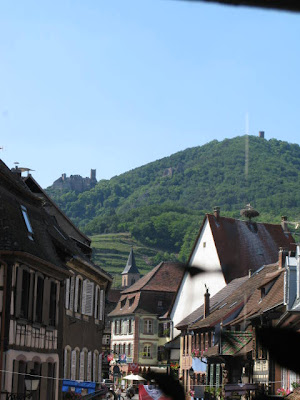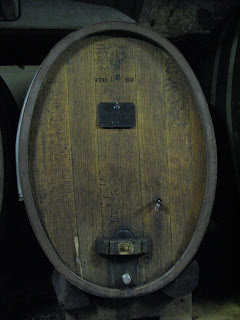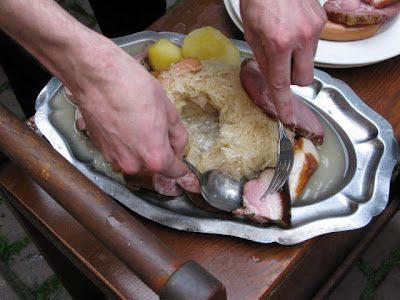 Bonjour à tous! Moi,
suis Brian. Hello, everybody. I’m Brian and welcome again to Cépage
et Cuisine, Mary’s and Brian’s wine and food blog. Today was our first day in Riquewihr and Alsace. The first order of business was to find the boulangerie and pick up a fresh
croissant for Mary. Naturally, it was
just a few doors down from our apartment.
Interestingly, this particular shop is more diverse in its offerings than the typical boulangerie of Burgundy and
is called a salon de thé, a tea
room. In addition to breads and
pastries, they serve coffee and tea.
I’ve been saying to Mary the boulangerie business model cries out for
great coffee and here it is! A small
grocery is right across the street, Rue
du Général de Gaulle, where I could get her favorite breakfast beverage, jus de pamplemousse rose, pink
grapefruit juice.
Bonjour à tous! Moi,
suis Brian. Hello, everybody. I’m Brian and welcome again to Cépage
et Cuisine, Mary’s and Brian’s wine and food blog. Today was our first day in Riquewihr and Alsace. The first order of business was to find the boulangerie and pick up a fresh
croissant for Mary. Naturally, it was
just a few doors down from our apartment.
Interestingly, this particular shop is more diverse in its offerings than the typical boulangerie of Burgundy and
is called a salon de thé, a tea
room. In addition to breads and
pastries, they serve coffee and tea.
I’ve been saying to Mary the boulangerie business model cries out for
great coffee and here it is! A small
grocery is right across the street, Rue
du Général de Gaulle, where I could get her favorite breakfast beverage, jus de pamplemousse rose, pink
grapefruit juice. I went for a morning jog and saw this sign. What luck!
Market day! We strolled to the
market, which was set up near the ramparts of the old fortified city of
Riquewihr.
I went for a morning jog and saw this sign. What luck!
Market day! We strolled to the
market, which was set up near the ramparts of the old fortified city of
Riquewihr. We planned to cook dinner in the apartment that evening and hoped to
find what we needed. By Beaune market
standards, the Riquewihr market was modest, perhaps a half dozen vendors and
not very busy. We picked up some nice cuisse de poulet rôtis, roast chicken
quarters ...
We planned to cook dinner in the apartment that evening and hoped to
find what we needed. By Beaune market
standards, the Riquewihr market was modest, perhaps a half dozen vendors and
not very busy. We picked up some nice cuisse de poulet rôtis, roast chicken
quarters ...
some beautiful berries and vegetables ...
and locally produced cheese.
 Our appointment for today was at Domaine Louis Sipp, which was
recommended to us by members of an electronic wine bulletin board called Wine
Berserkers. We were greeted by Madame
Martine Sipp and taken into the cellars.
Located in the nearby village of Ribeauvillé (that accent mark at the
end means the name of the village is pronounced Ree-bo-vill-ay), the domaine
was established around the end of the first world war.
Our appointment for today was at Domaine Louis Sipp, which was
recommended to us by members of an electronic wine bulletin board called Wine
Berserkers. We were greeted by Madame
Martine Sipp and taken into the cellars.
Located in the nearby village of Ribeauvillé (that accent mark at the
end means the name of the village is pronounced Ree-bo-vill-ay), the domaine
was established around the end of the first world war.
The vats acquired at that time are still in use in the cellars
today. Large oak vats, called foudres, are used to ferment and age the
wine. Most of them are around 100 years old.
They are quite large with a small door at the bottom. Between each use, someone actually climbs
through that little opening to clean the inside of the vat. Amazing!
As time marches on, the family has acquired a few stainless
steel tanks, juxtaposing the old with the new.
After the visit to the cellar, Martine took us upstairs for
a tasting.
She had prepared personalized tasting sheets in advance of
our visit.
She listed on the tasting sheet, “To start with” … Pinot
Blanc Ribeauvillé, then we progressed through, “Riesling, the king of the
whites,” then, “Pinot Gris the all rounder,” and finally, “Gewürztraminer looking
for elegance.” Altogether, we tasted
through about a dozen wines.
Like many French wine producers, Martine is all about the
place. “Wine is part of our culture, not
just a beverage,” she said, as she prepared the stems and the wines.
The tasting included appellation wines as well as single vineyard Grand
Cru wines.
Once again, you see the container for spitting. Tasting through this many wines, it is essential
to spit to prevent becoming impaired by the alcohol. Everybody does it and it does not detract
from the tasting experience at all.
The most memorable part of the tasting was a side-by-side comparison of
two wines, both from Grand Cru vineyards, the 2007 Riesling Osterberg and the
2007 Riesling Kirchberg de Ribeauvillé.
The wines were from the same grape variety, Riesling, the same vintage,
the same village, harvested at about the same time, vinified in the same
method.
 The two vineyards are scarcely more than several hundred yards
apart. From our second floor window, we
could see both vineyards. One was more
east facing ...
The two vineyards are scarcely more than several hundred yards
apart. From our second floor window, we
could see both vineyards. One was more
east facing ...
... the other south facing.
The soil types are slightly different.
The difference in character and flavor of the two wines could not have
been more obvious! It is absolutely
clear that the wines expressed the unique terroir
of each site. She also opened a bottle
of a mature wine, the 1999 Riesling Kirchberg de Ribeauvillé, to demonstrate
how the wine evolves over time.
As I’ve said repeatedly here on the blog, it helps so much
to visit a wine region in order to understand the wine. As we talked with Martine about the wines and
the place, the conversation turned to pairing wines with food and general
preferences about wine. The focus on the
place was made even clearer to us when Martine asked, “What kind of soil do you
like?” She didn’t ask about flavor
preferences or style, sweet or dry, or other sensory traits. She asked about soil preference, of all
things. I think her orientation to
thinking about wine this way highlights how the French strive to make their
wine an expression of their place of origin.
A Riesling grown in one vineyard has a different expression than the
same grape in another vineyard. Soil
type … clay vs stone or sand, granite or limestone, alluvial or hillside, it’s
all about the place. This is a reason
why I think the culture of wine is so fascinating.
After more than two hours of a wonderful experience with
Martine, we purchased a bottle of the Riesling Kirchberg de Ribeauvillé to
enjoy with our dinner of roasted chicken and vegetables we bought at the
farmers market earlier in the day.
She had this display set up on the sidewalk outside the
domaine. Look at the prices, many under €10. The wine we bought, a Grand Cru, was only €19,
about $24 U.S.
 A few producers include this helpful scale on the back label to
indicate the level of dryness (sec)
and sweetness (liquoreux). The photos in this post indicate another way
in which Alsace is different from the rest of France. Notice the bottle shapes are the long, fluted
style, similar to Germany. Also,
the name of the grape is on the label.
In Burgundy, the name of
the grape is not on the label.
A few producers include this helpful scale on the back label to
indicate the level of dryness (sec)
and sweetness (liquoreux). The photos in this post indicate another way
in which Alsace is different from the rest of France. Notice the bottle shapes are the long, fluted
style, similar to Germany. Also,
the name of the grape is on the label.
In Burgundy, the name of
the grape is not on the label.
Here are my notes on the wine.
Domaine Louis Sipp
Riesling Alsace Kirchberg de Ribeauvillé 2007. This is one of the excellent wines we tasted
at Louis Sipp with Mme. Sipp. It comes
from a Grand Cru vineyard, very steep, facing in an easterly direction. It is fruity, round, but retains great
structure and minerality. It has a
slight residual sweetness. The aromas
were peach, apricot, citrus, and mineral notes.
The palate was medium in body, almost full, with good acidity, and
fruity peach, apricot, lime citrus, and the same minerality, described by
Martine as "fat." It was
wonderfully balanced, complex, with great length. 13.0% alcohol.
That’s our post for today.
We hope you enjoyed it. Keep
checking back at Cépage et Cuisine for more posts about our wine, food, and
cultural adventures in Alsace. In the
meantime,




















































